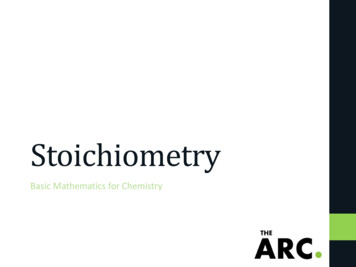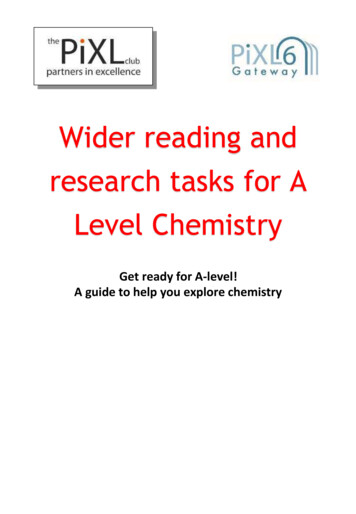
Transcription
StoichiometryBasic Mathematics for Chemistry
What will we discuss in thisworkshop? Who is this workshop for?What will I learn?How do I used the concepts?When will I use the concepts?Why is it important?
Who is this workshop for?*1
Who is this workshop for? General chemistry students People who do math problems for sciences Anyone else
What will I learn?*2
What is Stoichiometry? Stoichiometry ( /ˌstɔɪkiˈɒmɨtri/) is a branch of chemistry thatdeals with the relative quantities of reactants and products inchemical reactions
What is Stoichiometry usedfor? Converting between different unitsForming ratios between products and reactantsDescribing ratios between compounds in a reactionCalculating quantities of products or reactants (in mass,moles, volume, etc.)
How will I use the concepts?*3
How do you convert betweenunits? Multiply by clever values of one Keep track of your units
What is a clever value of one? Example 1: Converting between feet and inches We know that 12 inches 1 foot Thereforeis equal to 1, and hence, a clever value of 1 Example 2: Converting between moles and grams12inches 1 mole of Na 22.99g Na1 foot Thereforeis also equal to 11moleNa22.99 gramsNa
Why are units so important? Units help you keep track of your numbers Units help keep equalities true For example, we all know that there are 12 inches in 1 foot. Ifwe mixed up the units to read 12 feet per 1 inch, anyconversion we were trying to make would be incorrect.
1000meters1kilometer100centimeter s1meter1kilometer1000meters 100centimeter s*1kilometer1meter 100,000centimeter s 1kilometer *How do you convert between prefixes of the same unit? Metric prefixes help you convert between different quantities within the same unit Again, we multiply by a clever value of 1.
How can we use these concepts inChemistry? A balanced chemical equation will give you informationspecific to that reaction For example, the reactionfor the combustion ofmethane is: Note the coefficients: 1, 2, 1, 2 respectively Coefficients give a ratio of necessary starting materials andthe ratio of products made
Example 4: Finding the productgiven a reactant and a chemicalequation Question: Find the grams of carbon dioxide gas created when5.29 liters of methane gas at STP is combusted.
Example 4 continued Answer: First, gather all needed information (including clever values of 1) 1 mole of gas 22.4 liters at STP Molecular mass of: Carbon: 12 g/mol Hydrogen: 1 g/mol Oxygen: 16 g/mol Reaction coefficients:CH 4 2O2 CO2 2H 2O
Example 4 continued Answer continued: Next, start with what you are given in the question and multiplyby 1 until you arrive at your answer, making sure to keep track ofyour units5.29litersCH 4 5.29 LitersCH 4 *5.29 * 44gCO222.4 10.4 gCO2 1moleCH 41moleCO2 44 gCO2**22.4 LitersCH 4 1moleCH 4 1moleCO2
Example 5: A comprehensiveproblem Question: The reaction of powdered aluminum and iron(II)oxide,2Al(s) Fe2O3(s) Al2O3(s) 2Fe(l)produces so much heat the iron that forms is molten. Because of this,railroads use the reaction to provide molten steel to weld steel railstogether when laying track. Suppose that in one batch of reactants 4.20mol Al was mixed with 1.75 mol Fe2O3. Which reactant, if either, was the limiting reactant? Calculate the mass of iron (in grams) that can be formed from this mixture ofreactants.
Example 5 continued Answer Map: Step 1: Find the limiting reactant Step 2: Take the limiting reactant and multiply by clever values of 1,keeping track of units. Arrive at grams of Fe. Gather information: Molecular masses: Aluminum: 26.98 g/mol Iron: 55.85 g/mol Oxygen: 16 g/mol Equation coefficients: 2Al(s) Fe2O3(s) Al2O3(s) 2Fe(l)
Example 5 continued Answer continued Convert starting materials to moles 4.2 moles 2Al(s)4.2molesAl * 1.75 moles Fe2O3(s) Fe2O3 is the limiting reactant1rxn 2.1eqn2molesAl1.75molesFe2O3 *1rxn 1.75rxn1moleFe2O3
Example 5 continued Answer continued Find grams of iron formed from the limiting reactant bymultiplying by one1.75molesFe2O32molesFe 55.85 gFe 1.75molesFe2O3 **1moleFe 2O3 1moleFe 1.75 * 2 * 55.85 gFe 195 gFe
When will I use the concepts?*4
When will I use theseconcepts? Convert between units Calculations with a balanced chemical equation MolesVolumeDensityMass
Why is it important?*5
Why is it important? In school: Units and ratios must be correct to get the right solution Get good grades In the real world: bad ratios can have catastrophic and unintended consequences(explosions, toxins, waste of starting materials, waste of money,etc.)
References Wikipedia: http://en.wikipedia.org/wiki/Stoichiometry Chemistry, The Molecular Nature of Matter and Change, Silberberg 4thEdition, Chapter 3 Matter and its Changes, Brady, Russell, and Holum’s Chemistry,3rd Edition, Chapter 3 Prefix techtips table table4ametric-scinot.jpg Methane combustion reaction ges/VLC082 Balanced chemical equation.jpg
Example 5: A comprehensive problem Question: The reaction of powdered aluminum and iron(II)oxide, 2Al (s) Fe 2 O 3(s) Al 2 O 3(s)











